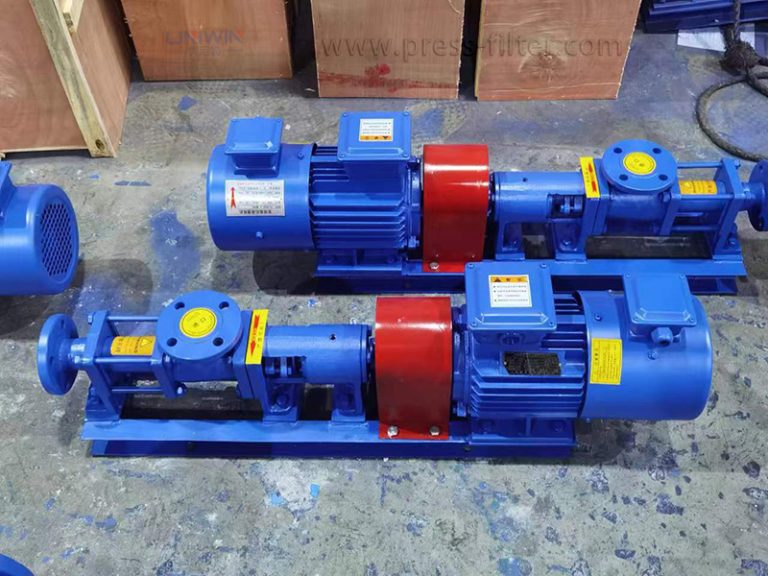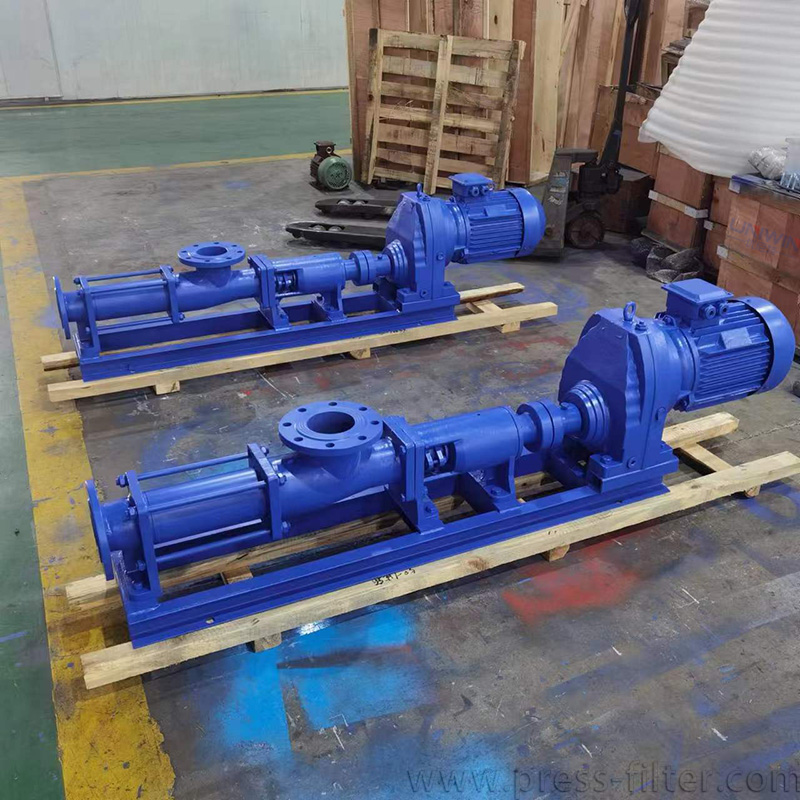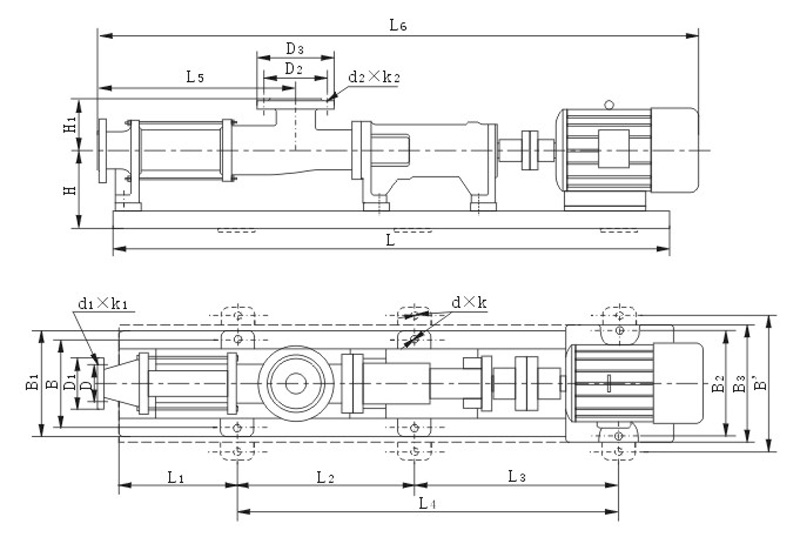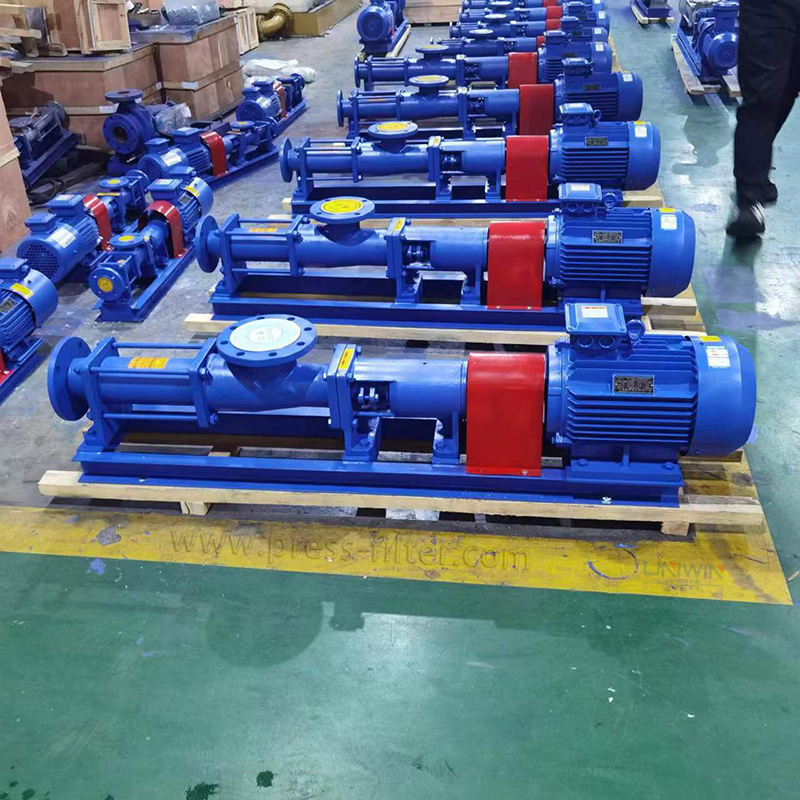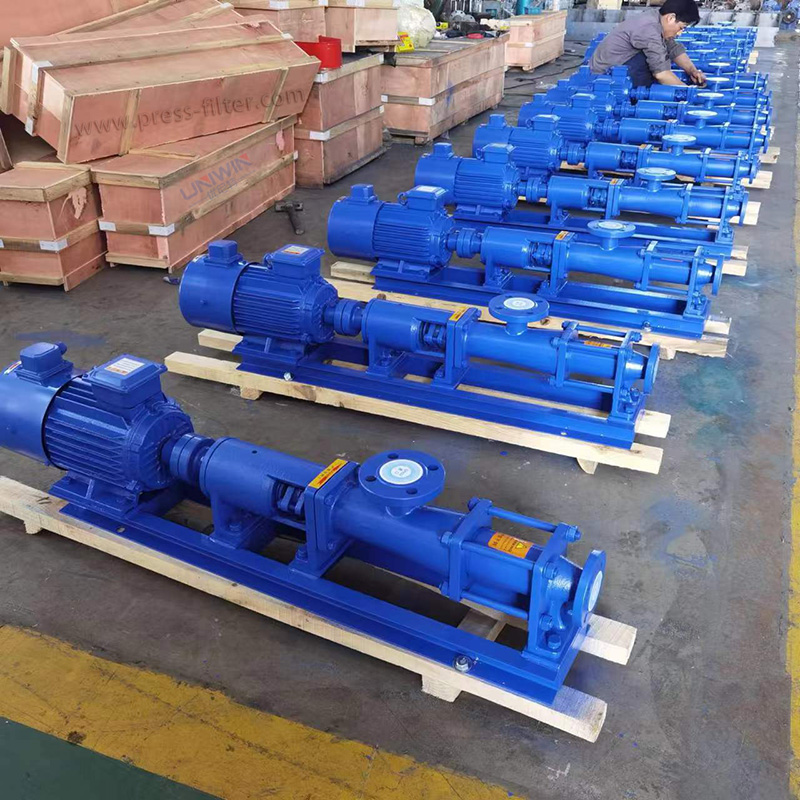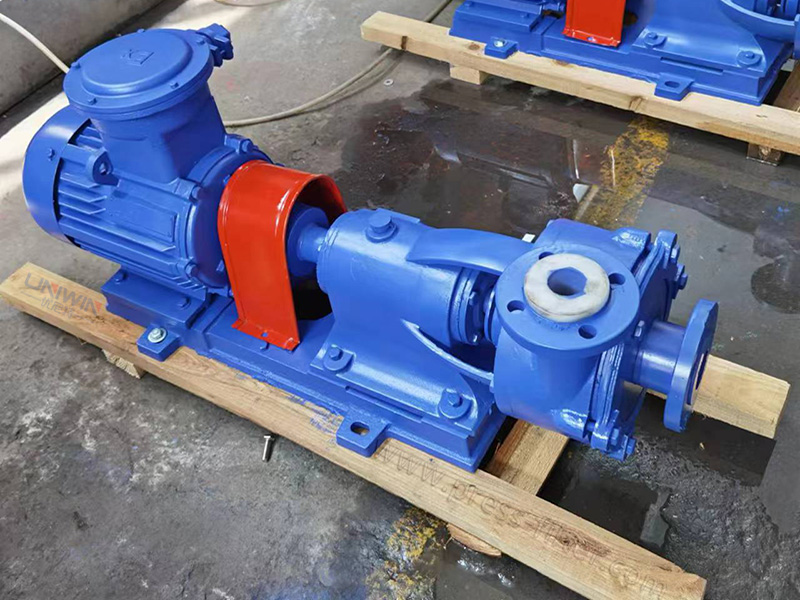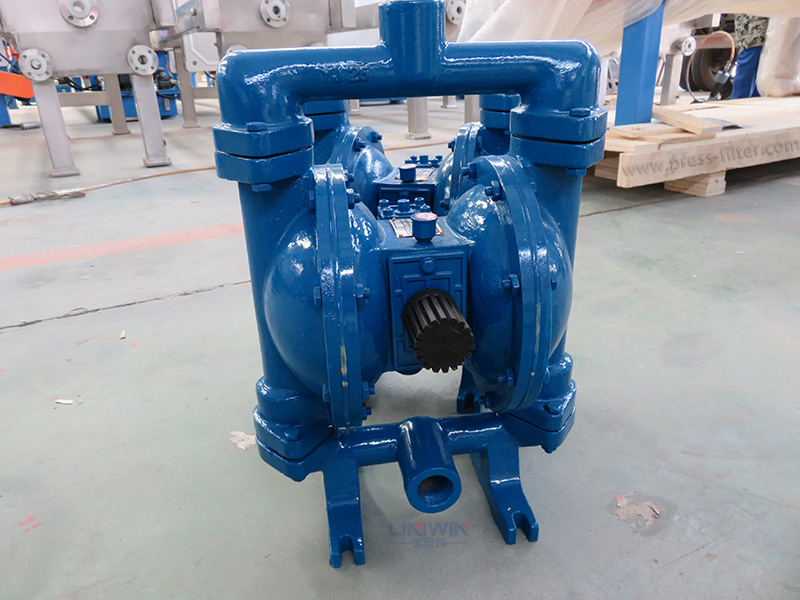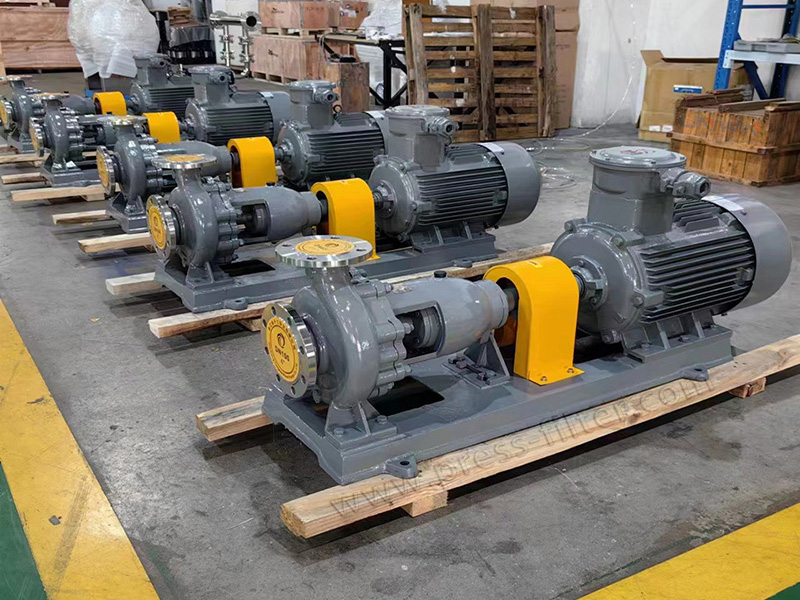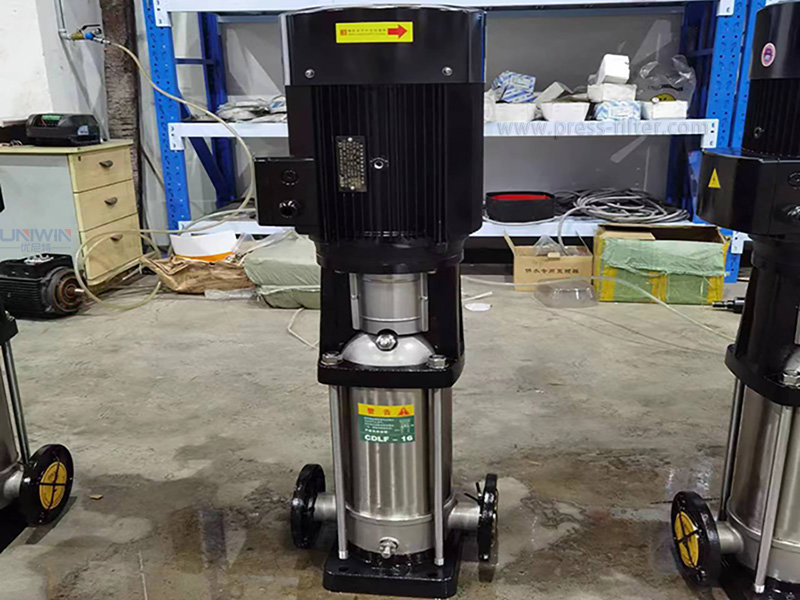Introduction to Filter Press Screw Pump
The G-type single screw pump often operates based on the rotary meshing volumetric principle. Its primary components, an eccentric screw (rotor) and a stationary bushing (stator) are crucial for ensuring the efficient processing of slurry in filter press applications.
The unique geometry of these components creates distinct sealed cavities, allowing the medium, often the slurry in filter press systems, to flow smoothly in the axial direction. This ensures a low internal flow rate, consistent volume, and stable pressure, which is essential for preventing eddy currents and agitation during the filtration process.
Unlike typical pumps, the G-type single-screw pump is specially designed to handle the challenges presented by filter presses, such as high-viscosity fluids, media with hard suspended particles, or fibrous content. Each stage of the pump has an output pressure of 0.6MPa, a lift of 60m (using clear water), and a self-priming height typically exceeding 3m, ensuring efficient slurry processing in filter press systems.
G-type Single Screw Pump Model Meaning
Example: FG 35-1
F——F means that the pump body and internal parts are all made of stainless steel. Without letters, the pump body is made of cast iron, and the internal parts are made of stainless steel.
G——G series screw pump.
35——Screw nominal diameter.
1——Indicates the primary pump; 2 indicates the secondary pump.
Main Features of Single Screw Pump for Filter Press
1. The single-screw slurry pump is straightforward in design, allowing for easy assembly, disassembly, and versatile initial installation options.
2. It boasts a notable suction capability, with its suction height reaching up to 6 meters in water column measurements.
3. The pump operates with consistency and quietness, free from pulsations or shearing effects.
4. It accommodates a broad temperature spectrum, handling mediums from -20℃ to +150℃.
5. With its minimalistic component design, the pump is compact, user-friendly, and features a long-lasting rotor and stator.
6. Drive options for the pump range from direct coupling to variable speed adjustments using mechanisms like speed-regulating motors, V-belts, or gearboxes.
Single Screw Pumps Parameter
| Model | Flow(m3/h) | Pressure(Mpa) | Allow high revolutions(r/min) | Motor power(kw) | Required NPSH(m) | Import flange diameter(mm) | Outlet flange diameter(mm) | Allowable particle diameter(mm) | Allowed fiber length(mm) |
|---|---|---|---|---|---|---|---|---|---|
| G20-1 | 0.8 | 0.6 | 960 | 0.75 | 4 | 25 | 25 | 1.5 | 25 |
| G20-2 | 1.2 | 1.5 | |||||||
| G25-1 | 2 | 0.6 | 960 | 1.5 | 32 | 25 | 2 | 30 | |
| G25-2 | 1.2 | 2.2 | |||||||
| G30-1 | 5 | 0.6 | 960 | 2.2 | 50 | 40 | 2.5 | 35 | |
| G30-2 | 1.2 | 3 | |||||||
| G35-1 | 8 | 0.6 | 960 | 3 | 65 | 50 | 3 | 40 | |
| G35-2 | 1.2 | 4 | |||||||
| G40-1 | 12 | 0.6 | 960 | 4 | 80 | 65 | 3.8 | 45 | |
| G40-2 | 1.2 | 5.5 | |||||||
| G50-1 | 20 | 0.6 | 960 | 5.5 | 4.5 | 100 | 80 | 5 | 50 |
| G50-2 | 1.2 | 7.5 | |||||||
| G60-1 | 30 | 0.6 | 720 | 11 | 5 | 125 | 100 | 6 | 60 |
| G60-2 | 1.2 | 15 | |||||||
| G70-1 | 45 | 0.6 | 720 | 11 | 150 | 125 | 8 | 70 | |
| G70-2 | 1.2 | 18.5 | |||||||
| G85-1 | 65 | 0.6 | 630 | 15 | 150 | 150 | 10 | 80 | |
| G85-2 | 1.2 | 30 | |||||||
| G105-1 | 100 | 0.6 | 500 | 30 | 200 | 200 | 15 | 110 | |
| G105-2 | 1.2 | 55 | |||||||
| G135-1 | 150 | 0.6 | 400 | 45 | 250 | 250 | 20 | 150 |
Please consult us for more models.
Comparison of Advantages between Screw Pumps and Other Pumps
1. Screw pumps maintain a stable linear flow without the need for valves, unlike centrifugal pumps.
2. Screw pumps excel in self-priming and have a higher suction height compared to plunger pumps.
3. Unlike diaphragm pumps, screw pumps can handle media mixed with gases, solid particles, fibers, and even various corrosive substances.
4. Screw pumps are adept at transporting high-viscosity materials, setting them apart from gear oil pumps.
5. Distinct from the plunger, diaphragm, and gear pumps, screw pumps are suitable for pharmaceutical filling and metering.
G-type Single Screw Pump Installation Dimensions
| Model | L | L1 | L2 | L3 | L4 | L5 | L6 | H | HI | B | B1 | B2 | B3 | B' | D | D1 | D2 | D3 | dxk | d1Xk1 | d2Xk2 |
|---|---|---|---|---|---|---|---|---|---|---|---|---|---|---|---|---|---|---|---|---|---|
| G20-1 | 1010 | 225 | 690 | 360 | 1150 | 150 | 95 | 160 | 190 | 185 | 215 | 85 | 115 | 85 | 115 | 4X12 | 4X14 | 4X14 | |||
| G25-1 | 1010 | 225 | 690 | 360 | 1150 | 150 | 95 | 160 | 190 | 185 | 215 | 85 | 115 | 100 | 135 | 4X12 | 4X14 | 4X14 | |||
| G25-2 | 1140 | 185 | 850 | 470 | 1280 | 150 | 95 | 160 | 200 | 220 | 250 | 85 | 115 | 100 | 135 | 4X12 | 4X14 | 4X14 | |||
| G30-1 | 1150 | 200 | 850 | 420 | 1300 | 170 | 130 | 195 | 225 | 220 | 250 | 110 | 145 | 125 | 160 | 4X12 | 4X18 | 4X18 | |||
| G30-2 | 1360 | 250 | 1000 | 575 | 1540 | 190 | 130 | 220 | 250 | 250 | 290 | 110 | 145 | 125 | 160 | 4X12 | 4X18 | 4X18 | |||
| G35-1 | 1230 | 225 | 890 | 450 | 1410 | 190 | 135 | 220 | 250 | 260 | 285 | 125 | 160 | 145 | 180 | 4X14 | 4X18 | 4X18 | |||
| G35-2 | 1450 | 125 | 600 | 600 | 615 | 1610 | 190 | 135 | 220 | 250 | 260 | 290 | 125 | 160 | 145 | 180 | 6X14 | 4X18 | 4X18 | ||
| G40-1 | 1350 | 225 | 990 | 470 | 1510 | 200 | 130 | 220 | 250 | 260 | 285 | 145 | 180 | 160 | 195 | 4X14 | 4X18 | 4X18 | |||
| G40-2 | 1540 | 120 | 650 | 650 | 665 | 1700 | 200 | 130 | 220 | 260 | 260 | 290 | 145 | 180 | 160 | 195 | 6X14 | 4X18 | 4X18 | ||
| G50-1 | 1480 | 135 | 580 | 630 | 550 | 1620 | 225 | 150 | 250 | 280 | 250 | 290 | 160 | 195 | 180 | 215 | 6X16 | 8X18 | 8X18 | ||
| G50-2 | 1800 | 140 | T60 | 760 | 790 | 1960 | 225 | 150 | 250 | 280 | 300 | 330 | 160 | 195 | 180 | 215 | 6X16 | 8X18 | 8X18 | ||
| G60-1 | 1720 | 175 | 680 | 690 | 570 | 1810 | 225 | 160 | 260 | 300 | 300 | 330 | 180 | 215 | 210 | 245 | 6X16 | 8X18 | 8X18 | ||
| G60-2 | 2040 | 200 | 800 | 800 | 820 | 2140 | 225 | 160 | 350 | 400 | 180 | 215 | 210 | 245 | 6X16 | 8X18 | 8X18 | ||||
| G70-1 | 1950 | 175 | 800 | 800 | 680 | 2120 | 245 | 150 | 350 | 400 | 210 | 245 | 240 | 280 | 6X18 | 8X18 | 8X18 | ||||
| G85-1 | 2620 | 210 | 1100 | 1100 | 945 | 2810 | 275 | 170 | 350 | 400 | 240 | 280 | 225 | 265 | 6X18 | 8X18 | 8X18 | ||||
| G105-1 | 1193 | 300 | 195 | 295 | 340 | 280 | 320 | 6X18 | 12X22 | 8X18 |
Finished Product Workshop
Operation Precautions
1. Ensure the machine is set in the correct direction before powering on; reversing is not advised.
2. Never operate the pump dry; doing so can damage the stator.
3. For newly installed pumps or those inactive for several days, don’t start them right away. First, introduce a suitable amount of engine oil or soapy water into the pump. Then, manually rotate it using a pipe wrench before powering it on.
4. After pumping high-viscosity or corrosive media with particles, cleanse the pump with water or a solvent to avoid blockages and ensure smooth startups in the future.
5. During winter, clear any residual fluid to prevent damage from freezing.
6. Regularly lubricate the bearing seat. If leakage is observed at the shaft end, attend to or replace the oil seal promptly.
7. Should any irregularities arise during operation, halt the machine immediately, investigate the issue, and rectify the problem.

